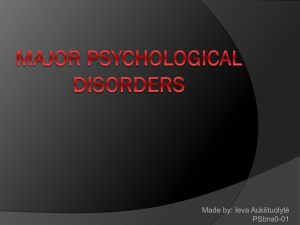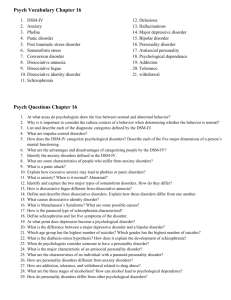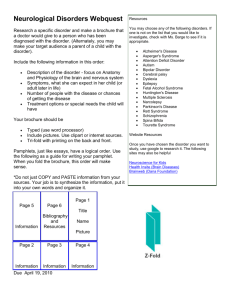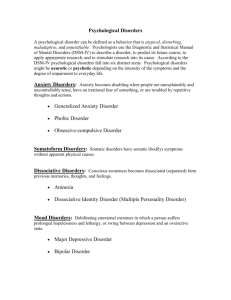Psychology 101: Introduction to Psychology
advertisement
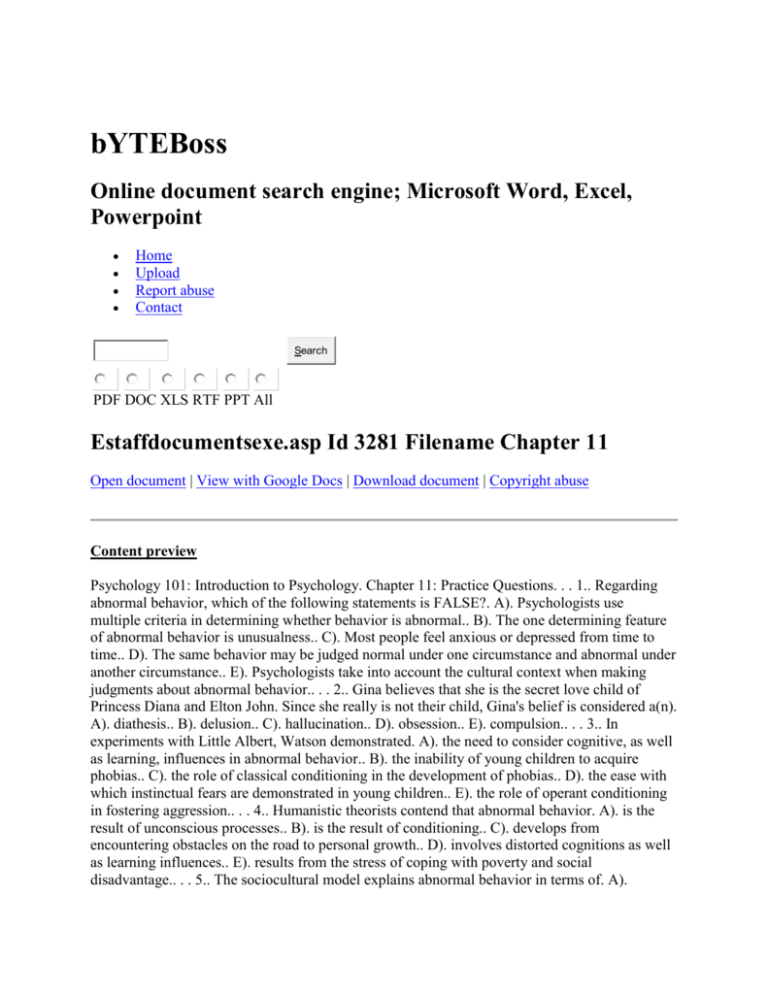
bYTEBoss Online document search engine; Microsoft Word, Excel, Powerpoint Home Upload Report abuse Contact Search PDF DOC XLS RTF PPT All Estaffdocumentsexe.asp Id 3281 Filename Chapter 11 Open document | View with Google Docs | Download document | Copyright abuse Content preview Psychology 101: Introduction to Psychology. Chapter 11: Practice Questions. . . 1.. Regarding abnormal behavior, which of the following statements is FALSE?. A). Psychologists use multiple criteria in determining whether behavior is abnormal.. B). The one determining feature of abnormal behavior is unusualness.. C). Most people feel anxious or depressed from time to time.. D). The same behavior may be judged normal under one circumstance and abnormal under another circumstance.. E). Psychologists take into account the cultural context when making judgments about abnormal behavior.. . . 2.. Gina believes that she is the secret love child of Princess Diana and Elton John. Since she really is not their child, Gina's belief is considered a(n). A). diathesis.. B). delusion.. C). hallucination.. D). obsession.. E). compulsion.. . . 3.. In experiments with Little Albert, Watson demonstrated. A). the need to consider cognitive, as well as learning, influences in abnormal behavior.. B). the inability of young children to acquire phobias.. C). the role of classical conditioning in the development of phobias.. D). the ease with which instinctual fears are demonstrated in young children.. E). the role of operant conditioning in fostering aggression.. . . 4.. Humanistic theorists contend that abnormal behavior. A). is the result of unconscious processes.. B). is the result of conditioning.. C). develops from encountering obstacles on the road to personal growth.. D). involves distorted cognitions as well as learning influences.. E). results from the stress of coping with poverty and social disadvantage.. . . 5.. The sociocultural model explains abnormal behavior in terms of. A). disturbed learning processes.. B). failures of society.. C). distorted thinking.. D). the failure of certain cultures to promote self-actualization.. E). social influences on underlying biological factors.. . . 6.. A diathesis is a. A). severely traumatic incident.. B). gene linked to a psychological disorder.. C). predisposition or vulnerability to a disorder.. D). learned pattern of abnormal behavior.. E). disturbance of mood, perception, or behavior.. . . 7.. The diathesis-stress model is an example of which model of abnormal behavior?. A). Humanistic. B). Cognitive. C). Psychodynamic. D). Sociocultural. E). Biopsychosocial. . . 8.. Regarding the diathesis-stress model, which of the following statements is FALSE?. A). Diatheses are generally genetic in nature, although they may also involve psychological factors.. B). Significant sources of stress may increase the risk of developing particular disorders.. C). The stronger the diathesis, the less stress is needed to produce a disorder.. D). Disorders may develop under benign life circumstances.. E). Whether a person having a diathesis develops a particular disorder is primarily dependent on their cluster of personality traits.. . . 9.. Distinctive patterns of abnormal behavior are described within the medical model as. A). psychological disorders.. B). biological disorders.. C). mental disorders or mental illnesses.. D). diatheses.. E). attributional styles.. . . 10.. Ella finds herself extremely frightened whenever she sees a snake. This is a form of. A). panic disorder.. B). specific phobia.. C). agoraphobia.. D). obsessive-compulsive disorder.. E). social phobia.. . . 11.. Fear of heights is to ______ as fear of enclosed spaces is to ______.. A). claustrophobia; acrophobia. B). acrophobia; claustrophobia. C). agoraphobia; claustrophobia. D). agoraphobia; acrophobia. E). acrophobia; agoraphobia. . . 12.. Persistent anxiety without a specific focus is called. A). generalized anxiety disorder.. B). obsessive-compulsive disorder.. C). agoraphobia.. D). social phobia.. E). panic disorder.. . . 13.. Whenever Fritz leaves his house, he has a nagging thought that he is forgetting something. He goes back to check that he has turned off the water and stove and locked the door. Some days, it takes Fritz over an hour to actually leave the house. This sounds like a case of. A). somatoform disorder.. B). obsessivecompulsive disorder.. C). agoraphobia.. D). panic disorder.. E). acrophobia.. . . 14.. Which of the following people is demonstrating an obsessive-compulsive disorder?. A). Buckie, who locks and unlocks her door three times each time she enters and leaves her home. B). Scott, who has a low-level state of anxiety that seems to travel with him wherever he goes. C). Rick, who has an irrational fear of riding on escalators. D). Mary Jo, who refuses to leave her house because going out in public makes her panic. E). Guillermo, who experiences sudden, unexpected episodes of sheer terror. . . 15.. Which of the following biological factors is MOST likely to be considered in the cognitive explanation of anxiety disorders?. A). Genetic inheritance. B). Biochemical changes in the brain. C). Disturbances in the functioning of neurotransmitters. D). Heightened activity in certain regions of the brain. E). Minor changes in bodily sensations. . . 16.. Discuss 4 types of anxiety disorders.. . . 17.. Dissociative identity disorder is a more technical term for. A). multiple personality disorder.. B). neurosis.. C). schizophrenia.. D). generalized anxiety disorder.. E). antisocial personality disorder.. . . 18.. Dissociative amnesia is. A). a loss of memory due to head trauma.. B). another term for dissociative identity disorder.. C). another term for multiple personality disorder.. D). a loss of memory with no identifiable physical cause.. E). a loss of memory due to a neurological condition.. . . 19.. Different personalities in dissociative identity disorder may demonstrate all of the following EXCEPT. A). different eyeglass prescriptions.. B). different allergic reactions and responses to medication.. C). different traits and manners of speech.. D). different eye colors.. E). different memories.. . . 20.. Regarding dissociative disorders, which of the following statements is FALSE?. A). Dissociative disorders can involve amnesia.. B). Dissociative disorders include cases of people with “multiple personalities.―. C). Dissociative disorders are among the most mystifying of psychological disorders.. D). Compared to other psychological disorders, dissociative disorders are relatively common.. E). Some mental health professionals question the existence of dissociative identity disorder.. . . 21.. Although they have different symptoms and characteristics, dissociative disorders and somatoform disorders are often grouped together because they both involve _______ defenses against _____.. A). physical; anxiety. B). physical; depression. C). psychological; mania. D). psychological; depression. E). psychological; anxiety. . . 22.. Critics of the concept of dissociative identity disorder suggest. A). it is really a form a schizophrenia.. B). it represents a form of attention-seeking role playing.. C). there are underlying physical causes that are unidentified.. D). it is not really an abnormal condition.. E). it fails to provide secondary gain.. . . 23.. Physical complaints that cannot be explained medically are characteristic of. A). dissociative identity disorder.. B). obsessive-compulsive disorder.. C). somatoform disorders.. D). dissociative amnesia.. E). bipolar disorder.. . . 24.. Describe two dissociative disorders and two somatoform disorders.. . . 25.. “La belle indifference― describes which feature of a psychological disorder?. A). The tendency for people with conversion disorder to be unconcerned about their symptoms. B). The tendency for people with dissociative identity disorder to have been highly imaginative as children. C). The tendency for people with depression to have a maladaptive attributional style. D). The tendency for people with bipolar disorder to swing dramatically from one end of the mood spectrum to the other. E). The tendency for people with depression to show indifference toward their future. . . 26.. Regarding major depressive disorder,. A). men are more likely than women to be diagnosed.. B). men and women are equally likely to be diagnosed.. C). women are more likely than men to be diagnosed.. D). young women are more likely than young men to be diagnosed and the pattern reverses in middle age.. E). young men are more likely than young women to be diagnosed and the pattern reverses in middle age.. . . 27.. Bipolar disorder was formerly called. A). manic-depression.. B). hysteria.. C). hypochondriasis.. D). multiple personality disorder.. E). schizophrenia.. . . 28.. Which theory would attribute a person's depression to faulty interpretation of events?. A). Cognitive. B). Humanistic. C). Psychodynamic. D). Behavior. E). Sociocultural. . . 29.. Which theorist is associated with the study of learned helplessness?. A). Aaron Beck. B). Albert Ellis. C). Albert Bandura. D). Carl Rogers. E). Martin Seligman. . . 30.. Exaggerating the importance of negative events or personal flaws is an example of which type of cognitive distortion?. A). All-or-nothing thinking. B). Misfortune telling. C). Catastrophizing. D). Dismissing the positives. E). Misplaced blame. . . 31.. The removal of normal restraints that serve to keep impulsive behaviors in check is called. A). an exit event.. B). a cognitive distortion.. C). a negative symptom.. D). waxy flexibility.. E). the disinhibition effect.. . . 32.. The disorder that most resembles common notions of insanity, madness, or lunacy is. A). major depressive disorder.. B). dissociative identity disorder.. C). generalized anxiety disorder.. D). schizophrenia.. E). bipolar disorder.. . . 33.. Schizophrenia, follows a _______ and typically develops _______.. A). chronic but not lifelong course; in early adolescence. B). lifelong course; in early adolescence. C). chronic but not lifelong course; in late adolescence or early adulthood. D). lifelong course; in late adolescence or early adulthood. E). variable course; during the person's thirties. . . 34.. Hallucinations are. A). perceptions that occur without appropriate external stimuli.. B). false beliefs.. C). long strings of disconnected words.. D). patterns of agitated, purposeless motion.. E). a breakdown in the logical structure of thinking and speech.. . . 35.. Schizophrenia is a type of. A). anxiety disorder.. B). mood disorder.. C). personality disorder.. D). psychotic disorder.. E). dissociative disorder.. . . 36.. Tatiana is a schizophrenic patient with delusional thinking. What does Tatiana experience?. A). Perceptions that occur without appropriate external stimuli. B). False but firm beliefs. C). Violent, aggressive outbursts. D). Patterns of disorganized speech. E). Removal of inhibitions resulting in violent outbursts. . . 37.. Which of the following is a negative symptom of schizophrenia?. A). Hallucinations. B). Delusions. C). Thought disorders. D). Social isolation. E). Bizarre behaviors. . . 38.. The most common form of hallucinations in schizophrenia is. A). visual.. B). olfactory.. C). auditory.. D). tactile.. E). kinesthetic.. . . 39.. Delusions of ______ are the most common theme among schizophrenics.. A). waxy flexibility. B). jealousy. C). la belle indifference. D). grandeur. E). persecution. . . 40.. A breakdown in the logical structure of thinking and speech, revealed in the form of a loosening of associations, is characteristic of which psychological disorder?. A). Antisocial personality disorder. B). Major depressive disorder. C). Obsessive-compulsive disorder. D). Dissociative identity disorder. E). Schizophrenia. . . 41.. Which of the following is a major type of schizophrenia?. A). Delusional. B). Depressive. C). Profound. D). Paranoid. E). Organized. . . 42.. Chaka suffers frequent delusional thoughts. He also experiences frequent auditory hallucinations. This is typical of which type of schizophrenia?. A). Psychotic. B). Paranoid. C). Catatonic. D). Disorganized. E). Hysterical. . . 43.. Personality disorders are a cluster of psychological disorders. A). involving extremely rigid patterns of behavior.. B). in which mood disturbances are the primary symptom.. C). which all include psychotic symptoms.. D). involving extreme anxiety.. E). in which cognitive distortions result in impaired functioning.. . . 44.. Mike has a grandiose sense of himself. This leads Mike to have an excessive need for admiration. Which personality disorder does Mike most likely have?. A). Schizoid. B). Paranoid. C). Narcissistic. D). Borderline. E). Dependent. . . 45.. Regarding personality disorders, which of the following statements is FALSE?. A). Personality disorders are characterized by self-defeating patterns of behavior.. B). Some people with personality disorders believe that others should change to accommodate their needs, rather than the reverse.. C). The DSM identifies ten types of personality disorders.. D). Of the personality disorders, the most widely studied is borderline personality disorder.. E). People with personality disorders have deeply ingrained maladaptive personality traits.. . . 46.. Extreme suspiciousness or mistrust of others is characteristic of which personality disorder?. A). Schizoid. B). Borderline. C). Paranoid. D). Narcissistic. E). Obsessive-compulsive. . . 47.. Which pattern best describes schizotypal personality disorder?. A). A tendency toward mood swings and stormy relationships with others. B). Extreme suspiciousness or mistrust of others. C). Little interest in social relationships and limited emotional expression. D). An inflated sense of self with excessive need for admiration. E). Persistent difficulties establishing close relationships; peculiar, but not psychotic, behaviors and beliefs. . . 48.. Diana has borderline personality disorder. Which of the following best describes the major symptom of her disorder?. A). Tendency toward mood swings and stormy relationships with others. B). Extreme suspiciousness or mistrust of others. C). Pattern of avoiding social relationships out of fear of rejection. D). Excessive need for orderliness and attention to detail. E). Odd or eccentric, but not psychotic, behaviors. . . 49.. Approximately what percentage of men could be classified as having antisocial personality disorder?. A). Less than 1%. B). 1 to 3%. C). 3 to 6%. D). 5 to 8%. E). 7 to 10%. . . 50.. Which of the following is NOT predicted to be exhibited by a person with histrionic personality disorder?. A). Excessive need for reassurance. B). Dramatic and emotional behavior. C). Excessive demand to be the center of attention. D). Excessive need for praise and approval. E). Tendencies to withdraw from other people. . . 51.. Individuals with antisocial personality disorder demonstrate all of the following EXCEPT. A). disregard for rules of society.. B). psychotic behavior.. C). lack of remorse for misdeeds.. D). impulsivity.. E). irresponsible behavior.. . . 52.. Summarize five personality disorders highlighted in your text.. . . Answer Key. . 1.. B. 2.. B. 3.. C. 4.. C. 5.. B. 6.. C. 7.. E. 8.. E. 9.. C. 10.. B. 11.. B. 12.. A. 13.. B. 14.. A. 15.. E. 16.. Four major types of anxiety disorders are phobias, panic disorder, generalized anxiety disorder, and obsessive-compulsive disorder. There are three types of phobias, a term which refers to an irrational or extreme fear of something. Social phobia is a fear of social interactions such as dating or giving a speech. Specific phobias are fears of very specific things, for example heights (acrophobia) or enclosed spaces (claustrophobia). Agoraphobia is the fear of going out in public. People with agoraphobia are typically terrified of leaving their home.. Panic disorder is characterized by sudden, inexplicable fits of terror. There is usually a combination of physical symptoms such as intense sweating, nausea, and numbness. People experiencing a panic attack may believe they are suffering a heart attack. People with panic disorder may develop agoraphobia. . Generalized anxiety disorder (GAD) includes a chronic, unexplained sense of dread. There is usually no specific focus to the worry, and the anxiety may “float― around with the person to different circumstances. Other characteristics include shakiness, difficulty relaxing, and fidgeting.. People with obsessivecompulsive disorder (OCD) are plagued by insistent, repetitive thoughts (obsessions). These thoughts typically cause great anxiety. The person is then compelled to engage in some ritualistic, repetitive behavior (compulsion) to ward off the anxiety. A typical obsession has to do with germs. A person may have a great fear of being dirty, and as a result may wash his or her hands repeatedly, or take numerous baths or showers each day.. 17.. A. 18.. D. 19.. D. 20.. D. 21.. E. 22.. B. 23.. C. 24.. The dissociative and somatoform disorders are probably the most curious forms of mental illness. The dissociative disorders are characterized by problems with memory or alterations in consciousness or self-identity. Probably the most notorious psychological disorder is dissociative identity disorder (also known as multiple personality disorder). In this disorder, essentially, two or more completely different personalities occur within the same individual. In dissociative amnesia, an individual suffers from profound loss of memory (similar to retrograde amnesia) with no readily apparent biological or medical condition.. The somatoform disorders involve physical ailments or concerns in the absence that cannot be explained medically. In conversion disorder, the individual loses some aspect of physical function, for example, paralysis of one arm or loss of feeling from one hand. Interestingly, these people often are not unduly concerned about their condition. This is known as “la belle indifference.― In hypochondriasis, the patient is preoccupied with the fear that he or she is suffering from some serious medical condition, despite medical reassurances to the contrary. Although dissociative disorders and somatoform disorders have different symptoms, they are often classified together because they both represent psychological attempts to deal with anxiety.. 25.. A. 26.. C. 27.. A. 28.. A. 29.. E. 30.. C. 31.. E. 32.. D. 33.. D. 34.. A. 35.. D. 36.. B. 37.. D. 38.. C. 39.. E. 40.. E. 41.. D. 42.. B. 43.. A. 44.. C. 45.. D. 46.. C. 47.. E. 48.. A. 49.. C. 50.. E. 51.. B. 52.. The personality disorders are a category of mental illness characterized by extremely rigid patterns of behavior. Usually people with these disorders have significant difficulty maintaining personal relationships because they refuse to change to accommodate other people. Narcissistic personality disorder involves a greatly exaggerated sense of self, accompanied by a high need for admiration. Paranoid personality disorder is typified by an inordinate amount of suspiciousness and mistrust of others. In schizoid personality disorder, people have minimal interest in social relationships and a limited range of emotional expression; they appear aloof and distant. Individuals with borderline personality disorder have very stormy relationships and excessive mood swings, accompanied by an unstable self-image. Finally, antisocial personality disorder includes a wide variety of characteristics including a disregard for societal standards, a lack of concern for the welfare of others, and a lack of remorse for wrongdoing. Although people with this disorder are sometimes referred to as sociopaths or psychopaths, the majority do not engage in criminal behavior. In fact, many are highly intelligent and charming.. . . Search Wikipedia for eStaffDocumentsEXE.asp?id=3281&filename=Chapter+11 Search Bing for eStaffDocumentsEXE.asp?id=3281&filename=Chapter+11 Search Google for eStaffDocumentsEXE.asp?id=3281&filename=Chapter+11 Latest files Facilities Inspection Services Eastbay.pdf Facilities Inspection Services East Bay Aluminum Scaffold Bay Area.pdf Scaffolding Company, Aluminum Scaffold Bay Area Solar Farm Developers.pdf Solar Farm Developers Biotechnology Company San Francisco Bay Area.pdf Newomics BioTechnology Company San Francisco Bay Area Italfood Water Guide.pdf Importer & Wholesalers of Selected of Foreign and Domestic Food Products Deck Refinishing Walnutcreek.pdf AllproDeck,complete resource for Deck Refinishing, Interior and Exterior Painting, Deck Restoration, Power Washing in Walnut Creek,California. Light Duty Towing Roadside Assistance.pdf Action Towing & Road Service complete resource for Heavy & Medium Duty Towing, Light Duty Towing in California. Chocolate Ptca Balloon Catheter.pdf QTVascular,Innovative in Minimally Invasive Treatment for Vascular Disease Treatment product includes Balloon Catheters. Centrifugal Pumps Reliability.pdf Price Pump,Pump Manufacturer in California complete resource for Magnetically Driven Centrifugal Pumps, Close Coupled Centrifugal Pumps, Vertical Centrifugal Pumps, Air Operated Diaphragm(AOD) Pumps. Executive Search Firms San Francisco Bay Area.pdf Hager Executive Search,complete resource for Executive Search Firms in San Francisco Bay Area. Website thumbnail Thumbnail provided by www.webthumbnail.com Recommended PPTserum o Genetics and Primary Care What s New in Maternal o ExcelSnake satages_data. main_wks. apples. EsColor. goal. lC May draftmay. May 2009 Voting Records. Board Date. Ba Icai Delhi Nbfc 04 05 2013 ************************* Islamic University Of Gaza List of Subject Codes. Academic Offer. Programme Uil Tournament Result Slideshow Update PERSUASIVE SPEAKING 1st Place: Erin Dulaney - Hal webcola LookupTable. Answer. Biweekly. . Salary1. How do Radiation Safety Legislation Radiation Safety & Legislation. Dr. Rosaleen Dev Sme Nd Ivn SME and ND Partnership For The Next Level Who is CreationFallSalvation o CREATION,F ALL,SALVA TION THE BIBLICAL NARRATIVE HA o ch4 **** **** **** **** **** Grand Cen Micro L i t t l e T h i n g s M e a n A L o t F r o m M i c r o i n e q u i t i e s 0 9 3 5 1 9 R Q c 1 4 5 0 0 6 0 S 0 y u r t d i s i i c m a l Y U R T D I I S S K M U A F . Y U R T D I I S S K E M E K L V E Y A K I N L e t t e r a A i C o n s i g l i D i o c . E P a r r . l i E A s s i s t e n t i No thanks


